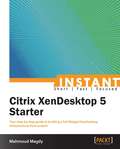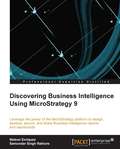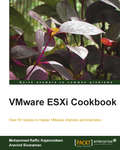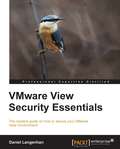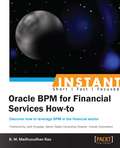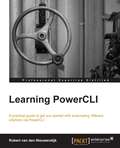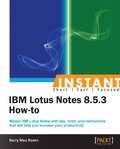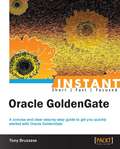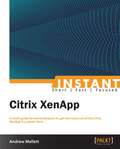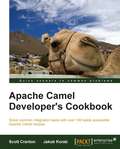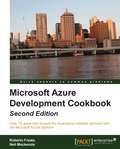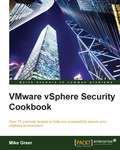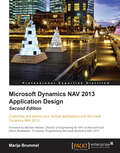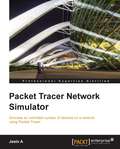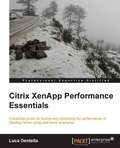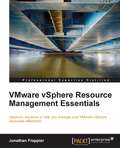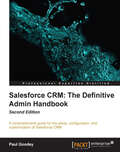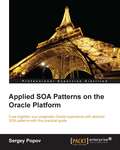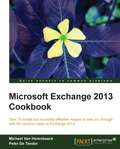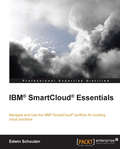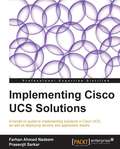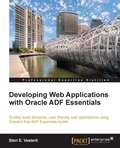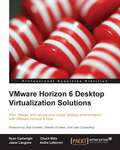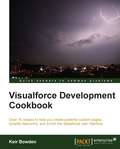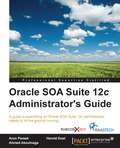- Table View
- List View
Instant Citrix XenDesktop 5 Starter
by Mahmoud MagdyGet to grips with a new technology, understand what it is and what it can do for you, and then get to work with the most important features and tasks. This easy-to-follow, hands-on guide shows you how to implement desktop virtualization with real life cases and step-by-step instructions. It is a tutorial with step-by-step instructions and adequate screenshots for the installation and administration of Citrix XenDesktop.If you are new to XenDesktop or are looking to build your skills in desktop virtualization, this is your step-by-step guide to learning Citrix XenDesktop. For those architects and designers experienced in XenDesktop infrastructure implementation this book aims to be a quick reference guide with notes and reminders for their day-to-day tasks.
Discovering Business Intelligence Using MicroStrategy 9
by Samundar Singh Rathore Nelson EnriquezThis is a step-by-step tutorial that covers the basics of working with the MicroStrategy platform.If you are a BI developer who would like to use MicroStrategy to build BI apps, this book is ideal for you. This book is also for mid-management executives who need to analyze data and Excel files that are too complicated to manage. A basic concept of BI is assumed.
VMware ESXi Cookbook
by Mohammed Raffic Kajamoideen Aravind Sivaraman"VMware ESXi 5.1" is written in a Cookbook style, learn through practical real world recipes and examples. "VMware ESXi 5.1 Cookbook" is written for technical professionals with system administration skills and foundation knowledge of virtualization and who need to learn about the installation, configuration, and administration of vSphere 5.1. Essential virtualization and ESX or ESXi knowledge is advantageous.
VMware View Security Essentials
by Daniel LangenhanA practical and fast-paced guide that gives you all the information you need to secure your virtual environment.This book is a "how-to" for the novice, a "reference guide" for the advanced user, and a "go to" for the experienced user in all the aspects of VMware View desktop virtualization security.
Instant Oracle BPM for Financial Services How-to
by B. M. RaoFilled with practical, step-by-step instructions and clear explanations for the most important and useful tasks. This book is a practical Packt How-to guide that is designed to provide targeted information for experienced BPM professionals in the financial sector.This book will be ideal as a pocket guide for people working with BPM for financial services. It is a short reference for financial analysts, business process owners, process participants, business process developers, and SOA and BPM architects and developers.
Learning PowerCLI
by Robert Van Nieuwendijk"Learning PowerCLI" is written in a friendly and practical style with a focus on getting you started and automating daily tasks quickly and efficiently. If you manage or administrate a vSphere environment, and want to make that easier and more efficient, then this book is for you! This book is ideal for you if you want to learn how to automate your VMware vSphere infrastructure, by getting the most out of PowerCLI. It's assumed that you have some experience in administrating a VMware vSphere environment. Knowledge of Microsoft's Windows PowerShell is not a prerequisite.
Instant IBM Lotus Notes 8.5.3 How-to
by Barry Max RosenGet to grips with a new technology, understand what it is and what it can do for you, and then get to work with the most important features and tasks.A Packt Instant How-to guide, which provides a quick and easy way to get started with IBM Lotus Notes 8.5.3.If you are brand new to Lotus Notes, a seasoned professional, or you are coming from Microsoft Outlook, this book will enable you to work smarter not harder in Lotus Notes 8.5.3.
Instant Oracle GoldenGate
by Tony BruzzeseFilled with practical, step-by-step instructions and clear explanations for the most important and useful tasks. Get the job done and learn as you go. A how-To book with practical recipes accompanied with rich screenshots for easy comprehension.This is a Packt Instant How-to guide, which provides concise and clear recipes for performing the core task of replication using Oracle GoldenGate.The book is aimed at DBAs from any of popular RDBMS systems such as Oracle, SQL Server, Teradata, Sybase, and so on. The level of detail provides quick applicability to beginners and a handy review for more advanced administrators.
Instant Citrix XenApp
by Andrew MallettGet to grips with a new technology, understand what it is and what it can do for you, and then get to work with the most important features and tasks. This book is a great tool to quickly learn and explore the features offered by XenApp 6.5.Windows system administrators who want a quick lesson on how to install and configure XenApp.
Apache Camel Developer's Cookbook
by Scott Cranton Jakub KorabThis book is written in a Cookbook style with short recipes showing developers how to effectively implement EIP without breaking everything in the process. It is concise and to the point, and it helps developers get their data flowing between different components without the need to read through page upon page of theory, while also enabling the reader to learn how to create exciting new projects.Camel Enterprise Integration Cookbook is intended for developers who have some familiarity with Apache Camel and who want a quick lookup reference to practical, proven tips on how to perform common tasks. Every recipe also includes a summary and reference pointers for more details that make it easy for you to get a deeper understanding of the Apache Camel capabilities that you will use day to day.
Microsoft Azure Development Cookbook Second Edition
by Neil Mackenzie Roberto FreatoIf you are an architect, this book will help you make the correct decisions about which Azure building blocks to use. If you are a developer, this book will help you understand how to use them appropriately, and if you are a .NET developer, this book is a pure delight.
VMware vSphere Security Cookbook
by Mike GreerThis book is intended for virtualization professionals who are experienced with the setup and configuration of VMware vSphere, but didn't get the opportunity to learn how to secure the environment properly.
Microsoft Dynamics NAV 2009 Application Design: Customize and extend your vertical applications with Microsoft Dynamics NAV 2013, 2nd Edition
by Mark BrummelThis book is a tutorial in an easy-to-read style. It will show Dynamics NAV developers how to create applications of different kinds with sufficient examples throughout. If you are a NAV consultant and developer, or designer of business applications you will benefit most from this book. The book assumes that you have a basic understanding of business management systems and application development, with a working knowledge of Microsoft Dynamics NAV.
Packet Tracer Network Simulator
by Jesin AA practical, fast-paced guide that gives you all the information you need to successfully create networks and simulate them using Packet Tracer. Packet Tracer Network Simulator is aimed at students, instructors, and network administrators who wish to use this simulator to learn how to perform networking instead of investing in expensive, specialized hardware. This book assumes that you have a good amount of Cisco networking knowledge, and it will focus more on Packet Tracer rather than networking.
Citrix XenApp Performance Essentials
by Luca DentellaA practical hands-on tutorial including multiple examples on application management using Citrix XenApp 6.5.Citrix XenApp Performance Essentials is intended for IT architects and system administrators who work with Citrix XenApp and who need an agile, practical guide to tune and optimize the performance.
VMware vSphere Resource Management Essentials
by Jonathan FrappierThis concise guide follows a practical approach, covering solutions and methods to manage resources for virtualization. If you are a current vSphere administrator who is aspiring to start your virtualization journey with VMware vSphere and wants to learn how to manage your resources, this is the book for you. Readers are expected to have some prior knowledge of ESXi and vCenter.
Salesforce CRM: The Definitive Admin Handbook
by Paul GoodeyA practical guide which will help to discover how to setup and configure the Salesforce CRM application. It offers solutions and practical examples on how to further improve and maintain its functionality with clear systematic instructions. Being highly organized and compact, this book contains detailed instructions with screenshots, diagrams, and tips that clearly describe how you can administer and configure complex Salesforce CRM functionality with absolute ease.This book is for administrators who want to develop and strengthen their Salesforce CRM skills in the areas of configuration and system management. Whether you are a novice or a more experienced admin, this book aims to enhance your knowledge and understanding of the Salesforce CRM platform and by the end of the book, you should be ready to administer Salesforce CRM in a real-world environment.
Applied SOA Patterns on the Oracle Platform
by Sergey PopovApplied SOA Patterns on the Oracle Platform is aimed at architects practicing SOA or traditional integration, and also at technical team leaders implementing Oracle Fusion under SCRUM or WF methodology.
Microsoft Exchange 2013 Cookbook
by Michael Van Horenbeeck Peter De TenderThis book is a practical, hands-on guide that provides the reader with a number of clear, step-by-step exercises."Microsoft Exchange 2013 Cookbook" is targeted at network administrators who deal with the Exchange server in their day-to-day jobs. It assumes you have some practical experience with previous versions of Exchange (although this is not a requirement), without being a subject matter expert.
IBM® SmartCloud® Essentials
by Edwin SchoutenA practical, user-friendly guide that provides an introduction to cloud computing using IBM SmartCloud, along with a thorough understanding of resource management in a cloud environment.This book is great for anyone who wants to get a grasp of what cloud computing is and what IBM SmartCloud has to offer. If you are an IT specialist, IT architect, system administrator, or a developer who wants to thoroughly understand the cloud computing resource model, this book is ideal for you. No prior knowledge of cloud computing is expected.
Implementing Cisco UCS Solutions
by Prasenjit Sarkar Farhan Ahmed NadeemA tutorial-based approach which will help you understand the practical methodologies and deploying of Cisco UCS components.If you are a professional such as a system, network, or storage administrator who is responsible for Cisco UCS deployments, this is the perfect book for you. You should have some basic knowledge of the server's architecture, network, and storage technologies. Familiarity with virtualization technologies is also recommended (though not necessary) as the majority of real-world UCS deployments run virtualized loads. Knowledge of Nexus OS is not necessary as the majority of the management tasks are handled in a graphical user interface with very few exceptions using the CLI.
Developing Web Applications with Oracle ADF Essentials
by Sten E. VesterliDeveloping Web Applications with Oracle ADF Essentials covers the basics of Oracle ADF and then works through more complex topics such as debugging and logging features and JAAS Security in JDeveloper as the reader gains more skills. This book will follow a tutorial approach, using a practical example, with the content and tasks getting harder throughout."Developing Web Applications with Oracle ADF Essentials" is for you if you want to build modern, user-friendly web applications for all kinds of data gathering, analysis, and presentations. You do not need to know any advanced HTML or JavaScript programming. Business logic can be implemented by adding Java code at well-defined hook points, so you do not need do know advanced object-oriented programming--regular Java programming skills are enough.
VMware Horizon 6 Desktop Virtualization Solutions
by Ryan Cartwright Chuck MillsIf you are a desktop architect, solution provider, end-user consultant, virtualization engineer, or anyone who wants to learn how to plan and design the implementation of a virtual desktop solution based on Horizon 6, then this book is for you. An understanding of VMware vSphere fundamentals coupled with experience in the installation or administration of a VMware environment would be a plus during reading.
Visualforce Development Cookbook
by Keir BowdenVisualforce Development Cookbook is written in such a way that even complex concepts are explained in an easy-to-understand manner. Following a Cookbook structure, the book covers some essential technical scenarios and includes over 75 recipes focusing on real-world development problems. This book is packed with illustrations and also contains lots of code samples for the better understanding of the reader."Visualforce Development Cookbook" is aimed at developers who have already grasped the basics of Visualforce. Awareness of the standard component library and the purpose of controllers is expected.
Oracle SOA Suite 12c Administrator's Guide
by Arun Pareek Ahmed Aboulnaga Harold DostA guide to everything an Oracle SOA Suite 12c administrator needs to hit the ground running About This Book * Understand core administrative tasks such as deployments, purging, startup and shutdown, configuration, and backup and recovery * Manage, monitor, and troubleshoot SOA composites and OSB services * Follow step-by-step instructions to easily and quickly install a highly available two-node cluster Who This Book Is For With topic areas ranging from the simple to the complex, this book is intended for novice, mid-level, and experienced administrators of the Oracle SOA Suite 12c platform as well as Oracle WebLogic Server and Oracle Database administrators interested in diving into the product. What You Will Learn * Navigate Oracle Enterprise Manager Fusion Middleware Control * Monitor and manage the Oracle SOA Suite 12 c infrastructure * Deploy and promote code * Monitor and manage services * Configure and administer the environment * Manage the dehydration store and enterprise scheduler service * Troubleshoot Oracle SOA Suite 12c infrastructure * Set up backups, recovery, and high availability In Detail Oracle SOA Suite 12 c is the most comprehensive and integrated infrastructure on the market today that is used for building applications based on service-oriented architecture. With the vast number of features and capabilities that Oracle SOA Suite 12c has to offer comes numerous complexities and challenges for administration. Oracle SOA Suite 12c Administrator's Guide covers all the core areas of administration needed for you to effectively manage and monitor the Oracle SOA Suite environment and its transactions, from deployments, to monitoring, to performance tuning, and much, much more. Manage, monitor, and troubleshoot SOA composites and OSB services from a single product set. Understand core administrative activities such as deployments, purging, startup and shutdown, configuration, backup, and recovery. Also learn about new features such as Oracle Enterprise Scheduler, lazy loading, work manager groups, high availability, and more. Style and approach Presented in a reference guide format where chapters can be read in any sequence, this book explains the core concepts while providing real-world implementation specifics, detailing the what, why, and how of all the administration-related activities that involve Oracle SOA Suite 12c. We take a step-by-step approach and offers tips, instructions, and examples that you can easily follow and execute.
